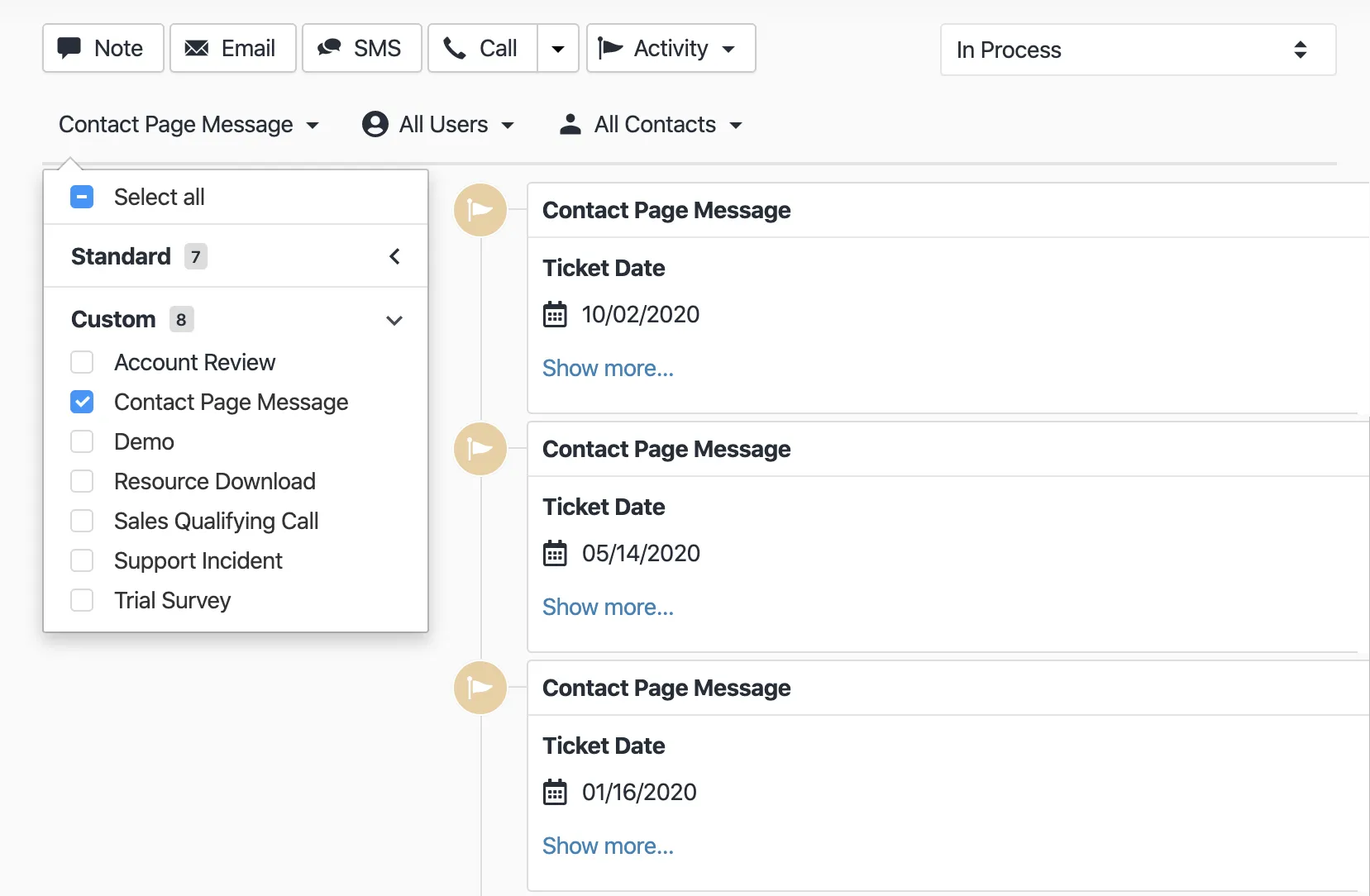
In einer idealen Welt würde jeder Lead einer geraden Linie durch Ihre Vertriebspipeline folgen, als ob er auf einer Wasserrutsche in einem Vergnügungspark fahren würde. Am Ende der Fahrt würden sie mit einem lauten Knall zum Abschluss kommen, und Ihr gesamtes Vertriebsteam würde Ihnen für Ihre hervorragende Arbeit applaudieren.
Aber in der Realität ist das einfach nicht der Fall.
Manchmal gleicht Ihr Verkaufsprozess eher einer großen Achterbahn, die viele unerwartete Wendungen nimmt, bis sie ihr Ende erreicht.
Für viele Vertriebsteams kann der Abschluss eines Geschäfts Monate und mehrere Kontaktpunkte mit einem potenziellen Kunden erfordern. Dieser Prozess ist für jedes Geschäft, jedes Unternehmen und jedes Vertriebsteam einzigartig.
Dennoch folgen immer noch zu viele Unternehmen einem allgemeinen Vertriebsleitfaden - und zu viele CRM-Systeme behandeln den Vertriebsprozess als eine Einheitsgröße für alle.
Aus diesem Grund haben wir Custom Activities in Close entwickelt: Eine maßgeschneiderte Sicht auf alle Kontaktpunkte innerhalb und außerhalb Ihres CRM. Mit benutzerdefinierten Aktivitäten können Sie Ihren eigenen Weg wählen und Daten auf der Grundlage Ihres individuellen Ansatzes aufzeichnen.
Fangen wir gleich damit an...
Was ist eine benutzerdefinierte Aktivität, und wie kann sie Ihren Vertriebs-Workflow optimieren?
In Close können vier Standardaktivitäten von der Lead-Seite aus gestartet werden: Notiz, E-Mail, SMS und Anruf. Diese vier sind entscheidend für den Verkaufsprozess, aber sie sind nicht alles. Geben Sie ein: Benutzerdefinierte Aktivitäten.
Anstatt Ihren Vertriebsprozess nach den Möglichkeiten Ihres CRM zu gestalten, können Sie Ihr CRM nach dem Prozess ausrichten, der für Ihr Unternehmen am besten geeignet ist.
Mit dieser neuen Funktion können Sie die Aktivitäten definieren, die Ihr Team protokollieren und über die es berichten soll, einschließlich...
- Anrufe zur Ermittlung und Qualifizierung
- Abgeschlossene Demos
- Teilnahme am Webinar
- Messegespräche
- Ausgefüllte Formulare
- Verbindungen zu sozialen Medien
- ...oder einfach alles, was Ihnen sonst noch einfällt!
Innerhalb dieser Aktivitäten können Sie Felder auswählen, die vorausgefüllt werden sollen, um Ihrem Team eine Struktur für die Informationen zu geben, die an jedem Kontaktpunkt erfasst werden sollen.
Zum Beispiel:
- Qualifizierungsanrufe können spezifische Fragen enthalten, die die Mitarbeiter stellen sollen, sowie Felder zum Ausfüllen der erhaltenen Antworten.
- Ein Offline-Touchpoint, z. B. ein Gespräch auf einer Messe oder einem Networking-Event, kann eine benutzerdefinierte Aktivität sein, die Felder enthält, in die die Vertreter die Informationen eintragen können, die sie erfahren haben.
- Berührungspunkte in sozialen Medien können in einer vorstrukturierten Weise aufgezeichnet werden, die mit Ihrem Prozess für Social Selling übereinstimmt.
Wenn diese benutzerdefinierten Aktivitäten erstellt und ausgefüllt werden, werden diese Informationen auf der Lead-Seite protokolliert, und jeder in Ihrem Team befolgt genau das gleiche Format auf der Grundlage der Prozesse und Arbeitsabläufe, die für Ihr Unternehmen funktionieren.

Aus dem Silo des Verkaufsteams ausbrechen
Wir bei Close haben uns schon immer auf Vertriebsteams konzentriert, aber wir wissen auch, dass ein effizienter Geschäftsabschluss ohne die harte Arbeit anderer Teams in Ihrem Unternehmen schwierig wäre.
Leider haben die meisten Vertriebsmitarbeiter nur einen begrenzten Überblick über die Interaktionen ihrer Leads und potenziellen Kunden mit Marketing, Kundendienst und Kundenerfolg.
Haben Ihre Leads kürzlich an einem Webinar teilgenommen, das vom Marketingteam organisiert wurde? Hat ein Kunde, dessen Abonnement zur Erneuerung ansteht, ein Support-Ticket offen? Hat ein Kunde gegenüber dem Erfolgsteam Interesse an einem Upgrade seines Kontos bekundet?
Mit benutzerdefinierten Aktivitäten kann Ihr Vertriebsteam die Kontaktpunkte seiner Leads im gesamten Unternehmen aus der Vogelperspektive betrachten.
Anstatt sich bei der Arbeit mit demselben Lead oder Kunden gegenseitig auf die Füße zu treten, können Sie diese verschiedenen Berührungspunkte zu Ihrem Vorteil nutzen und jedes Gespräch mit einem besseren Verständnis für Ihre Leads und deren Bedürfnisse beginnen.
Möchten Sie sehen, wie benutzerdefinierte Aktivitäten in der realen Welt aussehen?
Brauchen Sie Inspiration? 7 Anwendungsfälle für benutzerdefinierte Aktivitäten zur Verstärkung Ihres Vertriebsprozesses
Jetzt wissen Sie also, was benutzerdefinierte Aktivitäten für Ihr Vertriebsteam leisten können. Aber wie sieht das in Ihrem Vertriebs-Workflow aus?
Sehen Sie sich sieben Anwendungsfälle an, die Sie in Ihren Prozess übernehmen können:
1️. Machen Sie strukturierte Gesprächsnotizen, die Ihrem Team tatsächlich helfen, den Deal Close
Wenn Sie mit einem Team arbeiten, können Sie durch einheitliche Fragen bei Ihren Verkaufsgesprächen Ihren Prozess standardisieren und schneller zu dem gelangen, was funktioniert. Mit benutzerdefinierten Aktivitäten können Sie eine Reihe von Feldern definieren, die jeder Vertriebsmitarbeiter bei seinen Anrufen ausfüllen muss, so dass es ein Kinderspiel ist, bei der Sache zu bleiben und Notizen zu vergleichen.
Beispiele:
- Qualifikationsaufrufe
- Entdeckungsanrufe
- Demos
- Notizen zur Anrufdisposition
Wie die KI von CoPilot wichtige Informationen während Discovery Calls sammelt
Das Kunden- und marktführende LinkedIn-Engagement-Tool von Close, CoPilot AI, lässt sein Team Erkundungsanrufe mit potenziellen Kunden durchführen, um sich mit dem idealen Zielprofil des jeweiligen Kunden abzustimmen. Sie erstellten eine benutzerdefinierte Aktivität mit einem Feld für alle ihre Schlüsselfragen. Bei jedem Discovery Call erstellen die CoPilot-Mitarbeiter eine benutzerdefinierte Aktivität für Discovery Insights und verwenden sie, um ihre Gesprächsnotizen zu vervollständigen.
Vor dem Ende des Gesprächs hat jeder Mitarbeiter alle wichtigen Informationen gesammelt und strukturiert gespeichert, so dass alle Teammitglieder den Anrufverlauf des Kunden leicht einsehen können.
Die Vorbelegung von Feldern bedeutet auch, dass ein neu eingestellter Vertreter gleich am ersten Tag zum Telefon greifen und potenzielle Kunden qualifizieren kann.
2️. Verschaffen Sie sich einen Überblick über den Kontakt Ihres Leads oder Kunden mit anderen Teams
Manchmal braucht es ein ganzes Dorf, um ein Geschäft abzuschließen, ganz gleich, ob Sie einen Testbenutzer konvertieren oder einen bestehenden Kunden verlängern wollen.
Um sich optimal zu präsentieren, müssen Sie wissen, ob die Person, mit der Sie Kontakt aufnehmen möchten, ein offenes Support-Ticket hat oder kürzlich in einem Usability-Test kritisches Feedback gegeben hat. Mit benutzerdefinierten Aktivitäten können Sie dies tun.
Ohne diese Einblicke stürzen Sie sich kopfüber in unangenehme Gespräche ohne Kontext oder Rückgriff. Wenn Sie jedoch frühere Berührungspunkte kennen, können Sie sich auf ein produktiveres Gespräch vorbereiten, das auf den Beschwerden des Kunden basiert, oder Ihre geplante Kontaktaufnahme verschieben.
Beispiele:
- Anfragen zur Unterstützung
- Andere Kommunikationsmittel (Intercom, Marketing-E-Mails)
- Benutzertests/Kundenbefragungen
3️. Verfolgen Sie, woher Ihre Leads stammen
Wenn Sie ein Geschäft abschließen, ist jedes bisschen Kontext hilfreich - zum Beispiel, wie der Lead überhaupt in Ihrem CRM gelandet ist. Wenn Sie wissen, dass ein Lead durch eine Kundenempfehlung oder eine (Online-)Veranstaltung zustande gekommen ist, haben Sie bereits einige Hintergrundinformationen, die Sie zu Ihrem Vorteil nutzen können, sei es, um Ihr Angebot zu optimieren oder eine Beziehung aufzubauen.
Beispiele:
- Formularübermittlung (Demo-Anfrage, Angebotsanfrage)
- Links zum Drift-Chat
- Besucher von Messeständen
- Verweise
4️. Mehr Touchpoints verfolgen, sowohl online als auch offline
Ein Lead kann mehrere Male mit Ihrem Team und Ihrem Unternehmen interagieren, bevor Sie ihn ans Telefon bekommen. Die Verfolgung dieser Berührungspunkte ist entscheidend, um ein vollständiges Verständnis der Reise des Leads mit Ihrem Unternehmen zu erlangen und mit dem entsprechenden Kontext in jedes Meeting zu gehen.
Grafik: Akzeptierte LinkedIn-Anfrage
Beispiele:
- Verbunden auf LinkedIn
- Treffen zum Mittagessen
- An einem Webinar teilgenommen
5️. Standardisieren Sie Ihre Kundenerfolgsprozesse
Nur weil das Geschäft abgeschlossen ist, heißt das nicht, dass der Verkaufsprozess beendet ist.
Der Lebenszyklus dieses Kunden beginnt gerade erst.
Sobald die Opportunity gewonnen ist, übergeben Sie die Fackel an ein Customer Success-Team, das für Verlängerungen und Upsells zuständig ist. Diese können genauso wichtig sein wie (wenn nicht sogar wichtiger als) der Erstverkauf.
Mithilfe von benutzerdefinierten Aktivitäten können Sie Daten zur Kundenzufriedenheit aus anderen Tools in Ihrem Stack in Close einbringen und die Art und Weise, wie Ihr Team seine Kontobewertungen durchführt, standardisieren.
Beispiele:
- Onboarding-Anrufe
- Vierteljährliche Geschäftsüberprüfungen/Kontoprüfungen
- Erneuerungsaufrufe
- NPS-Umfragen
6️. Stärken Sie Ihr Verständnis dafür, warum Sie Geschäfte gewinnen oder verlieren
Wenn Sie wissen, warum Ihr Team gewinnt oder verliert (und gegen wen Sie gewinnen oder verlieren), können Sie in Zukunft mehr Geschäfte abschließen. Durch das Sammeln standardisierter Gewinn-/Verlustdaten über benutzerdefinierte Aktivitäten können Sie besser verstehen, was bei jedem Geschäft richtig oder falsch gelaufen ist, und diese Daten nutzen, um die Wirkung Ihrer Botschaft für jeden Lead zu maximieren.
Beispiele:
- Details gewinnen
- Interviews/Daten zum Verlust
- Trends bei den Wettbewerbern
- Umfragen zur Anmeldung
- Umfragen zur Annullierung
Tiefergehende Integration mit Ihrem SaaS-Produkt
Wenn Sie in der SaaS-Branche tätig sind, wissen Sie, dass einige der wichtigsten Berührungspunkte während des Verkaufsprozesses innerhalb Ihres Produkts liegen. Durch die Verwendung von Custom Activities mit unserer leistungsstarken API können Sie jetzt die Punkte zwischen Ihrem SaaS-Tool und Ihrem CRM besser miteinander verbinden.
Erfassen Sie kritische Aktivitäten, wie z. B. den Beginn einer Testphase direkt auf der Lead-Seite, und erstellen Sie eine benutzerdefinierte Aktivität, um den Kunden zu kontaktieren, bevor seine Testphase abläuft.
Beispiele:
- Start- und Enddatum der Studie
- App-Aktivität
- Gesehene Downgrade/Upgrade-Seite
- Hinzugefügte/entfernte Benutzer
- Planänderungen
- Feature-Anfragen
Benutzerdefinierte Aktivitäten in Suche und intelligenten Ansichten verwenden
Mit der Suchfunktion Close können Sie Leads mit einer benutzerdefinierten Aktivität auf der Grundlage des Datums (Erstellungs- oder Aktualisierungsdatum), des Benutzers (der sie erstellt oder aktualisiert hat) oder eines beliebigen Feldes innerhalb dieser benutzerdefinierten Aktivität anzeigen. Für Suchvorgänge, auf die Sie häufig zugreifen müssen, können Sie diese Suche verwenden, um eine intelligente Ansicht zu erstellen, in der Sie die Ergebnisse immer griffbereit haben.
Sobald Sie sich auf einer Lead-Seite befinden, können Sie die benutzerdefinierten Aktivitäten Ihres Leads mithilfe des Aktivitätsfilters oben links auswählen.

Bereit zum Start?
Erstellen Sie Ihre erste benutzerdefinierte Aktivität in Close oder starten Sie Ihre kostenlose 14-tägige Testversion (keine Kreditkarte erforderlich).
Noch mehr Informationen über benutzerdefinierte Aktivitäten finden Sie in unserem Hilfe-Center.












